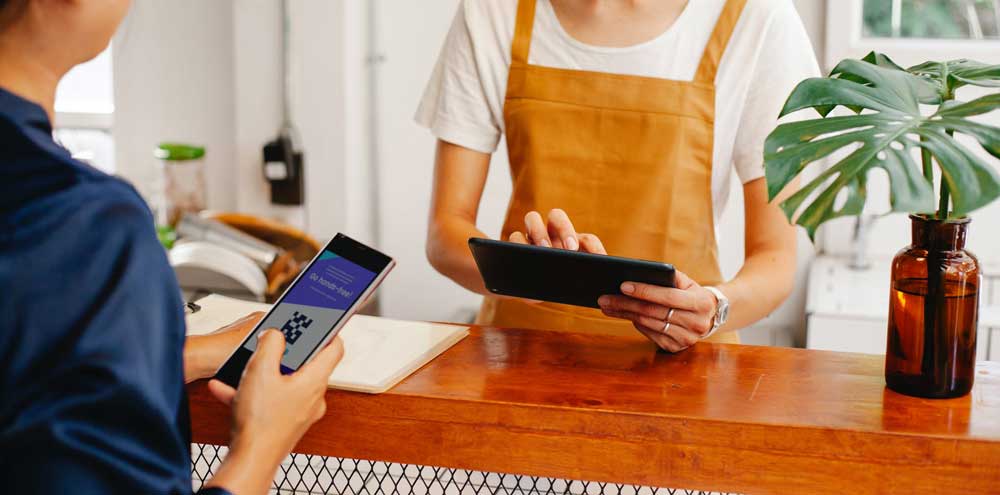Using QR Code Mobile Payments
The other day I went to my local coffee spot for a drink and some lunch. Behold on the table was a QR Code with table number so I thought I would give it a go.
When I scanned it, the menu came up and we choose our drinks and meal and it used Square nto take our order and payment.
The big problem was that today I went up again and trying to scan the QR Code whidid not work. The reason was it was printed on a stainless steel piece of metal and the contrast with the lighting was getting very low. Tried everything but the lighting made it impossible to get a good shot at this table.
QR Code Mobile Payments have revolutionized the payment system in Australia.
This technology allows customers to pay for goods and services using their smartphones. It is an easy, secure, and convenient way of payment.
You will notice it popping up in all types of retail and service industries. Restaraunts are linking to ordering menus, service companies collecting payment on the spot.
How it works is a business links a QR Code to a bank or merchant facility to collect generate orders etc and a payment system. Some of the more popular ones are Square and Stripe although there are many more.
In this review, we will discuss QR Code Mobile Payments in Australia, their benefits, drawbacks, and future potential.
QR Code Mobile Payments are popular in Australia due to their convenience and security.
Here are 10 QR code ordering systems available in Australia:
- Mr Yum – A QR code ordering system for cafes, bars, and restaurants that allows customers to order and pay using their smartphones.
- HungryHungry – A QR code ordering system for restaurants, cafes, bars, and hotels that enables customers to view menus, order food and drinks, and pay using their phones.
- Hey You – A mobile ordering and payment platform that provides a contactless ordering solution for cafes, restaurants, and food outlets.
- Tock – A QR code ordering system for restaurants, cafes, and bars that enables customers to reserve tables, order food and drinks, and pay using their phones.
- OrderUp – A QR code ordering system for cafes and restaurants that provides an easy-to-use mobile ordering and payment solution.
- Bopple – A QR code ordering system for cafes, bars, and restaurants that allows customers to order and pay using their smartphones.
- Mimu – A QR code ordering system for cafes, bars, and restaurants that provides a simple and easy-to-use mobile ordering solution.
- Skip – A mobile ordering and payment platform that enables customers to order and pay using their smartphones at cafes, restaurants, and food outlets.
- Doshii – A QR code ordering and payment system for cafes, restaurants, and bars that integrates with a range of point-of-sale systems.
- Yump – A mobile ordering and payment platform that provides a contactless ordering solution for cafes, restaurants, and food outlets.
Customers can use their smartphones to scan the QR code displayed at the point of sale, which automatically transfers the payment.
This eliminates the need for customers to carry cash or credit cards. Moreover, QR Code Mobile Payments are faster than traditional payment methods, making the checkout process smoother and quicker.
One of the key benefits of QR Code Mobile Payments is that they are secure.
The technology uses encryption and authentication to ensure that transactions are safe and secure. Furthermore, customers are not required to share their personal or financial information with merchants, which reduces the risk of identity theft and fraud.
Another benefit of QR Code Mobile Payments is that they are cost-effective for merchants.
The technology is affordable and easy to implement, making it an ideal solution for small businesses. Merchants do not have to invest in expensive payment terminals or hire additional staff to manage the payment process. Furthermore, QR Code Mobile Payments reduce the risk of errors and fraud, which can result in cost savings for merchants.
Despite the benefits of QR Code Mobile Payments, there are some drawbacks that need to be considered.
The first drawback is that not all customers have smartphones, which limits the adoption of the technology. Moreover, some customers may be hesitant to use QR Code Mobile Payments due to security concerns.
They may prefer traditional payment methods that they perceive to be more secure.
Another drawback of QR Code Mobile Payments is that they require a reliable internet connection. In areas where internet connectivity is poor, QR Code Mobile Payments may not work efficiently.
This could result in delays and inconvenience for customers, which could impact their willingness to use the technology.
The future potential of QR Code Mobile Payments in Australia is promising.
As the technology continues to evolve, it is expected that more customers will adopt it as their preferred payment method. QR Code Mobile Payments also have the potential to integrate with other technologies, such as artificial intelligence and blockchain, which could enhance their security and functionality.
QR Code Mobile Payments can help to promote financial inclusion.
They provide an alternative payment method for people who do not have access to traditional banking services. This could benefit low-income earners, migrants, and people living in rural areas.
In conclusion, QR Code Mobile Payments have revolutionized the payment system in Australia.
They are a convenient, secure, and cost-effective way of making payments.
However, their adoption is limited by the availability of smartphones and internet connectivity.
Nevertheless, the future potential of QR Code Mobile Payments in Australia is promising, and the technology is expected to continue to evolve and improve in the coming years.

